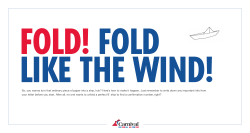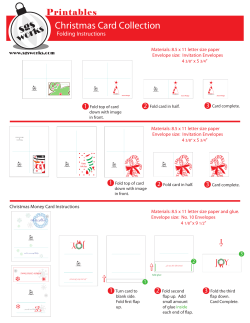
Natural Twig Journals
Natural Twig Journals (art + literature) This simple bookmaking project can achieve great results with a wide variety of ages. Using nature as a theme, it's a perfect place to record nature sketches, foliage collections and personal observations of the world around us. Grade Levels K-12 Note: instructions and materials based on a class of 25 students. Adjust as needed. Objectives • Students will learn a very basic bookbinding technique incorporating a dimensional object and simple fastening method • Students will recognize that a handmade book is a work of art in itself • Students will achieve step one in the creation of a finished piece of personal value. The art of creating the book will continue as Materials a sketchbook, writing surface or scrapbook is Heavy, textured paper to use for cover, developed recommend: Bark Paper (11240-) Preparation Garden Paper (11229-) ® ® 1. Tear or cut cover paper to desired size. The Canson Mi-Teintes Paper (10710-) Art Deckle ruler gives a natural Need at least an 8" x 10" piece per student handmade-look to the edge. Book size will ® vary according to sheet size and number of Canson Classic Cream Drawing Paper covers you wish to get from each sheet. (10323-1109), cut to fit inside cover page, need at least three sheets per student 2. Cut drawing paper for the inner pages. Make pages smaller than cover size. For example, if Binding material for spine, recommend: cover page is 8.5" x 11", cut pages to be Natural Copper Wire (33411-0200) 8" x 10.5". Decide on how many pages each Hemp Twine (60627-1036) student will have per book to determine Twisteez (33407-1050) quantity. Need approximately 6" per student 3. Cut wire into 4" to 6" pieces. ® Art Deckle Ruler (55413-1006), 12", share Process one between four students 1. Fold cover page in half. Place Acme™ Titanium Blade Scissors, small twig about 1/4" from the (57059-1005), need one per student folded edge. Using a sharp pencil, lightly make a mark Moore™ Push Pins (57307-1009), box of on either side of the twig at 100, need one per student the top, middle and bottom, Paper Clips, jumbo (57318-1050), box of (A) see (A). Remove twig, place 50, need one per student cover on magazine, and create holes through the front Blick Economy Graphite Pencil, box of 12, and back using marks as a (20302-2009), need one per student guide. Use push pin to pierce, Twig see (B). (B) 1. Process, continued 2. Tap pages together to align, then fold in half, making sure corners line up. Place pages inside cover, making sure page fold is all the way in, against cover fold. Use push pin to pierce holes in pages, using the holes already created in the cover, see (B). Pierce only 4-5 pages at a time. 3. Once all pages are pierced, assemble them all together in the cover and use paper clip to align holes and widen them if needed 4. Position twig back on the page and thread wire through hole on one side, then through hole on the other side. Secure by twisting ends of wire together, see (C). Snip off excess wire. 5. Embellish cover with nature stamp or sketches if desired. Options - If working with very young ages, it may be best to create holes for binding ahead of time. A hole punch can also be used. - If binding twig with twine, add more holes to stitch through - If decorative paper is unavailable for cover, try using heavy kraft paper (grocery sack) or light corrugated board for a natural look Copyright © 2006 Dick Blick Art Materials. All rights reserved. JD Bark paper cover, natural twig, bound with natural hemp twine (C) National Standards: Content Standard #1 — Understanding and applying media, techniques and processes • K-4 Students use different media, techniques and processes to communicate ideas, experiences and stories. • 5-8 Students intentionally take advantage of the qualities and characteristics of art media, techniques and processes to enhance communication of their experience and ideas. • 9-12 Students apply media, techniques and processes with sufficient skill, confidence and sensitivity that their intentions are carried out in their artworks. Content Standard #6 — Making connections between visual arts and other disciplines • K-4 Students understand and use similarities and differences between characteristics of the visual arts and other arts disciplines. • 5-8 Students compare the characteristics of works in two or more art forms that share similar subject matter, historical periods or cultural context. • 9-12 Students compare the materials, technologies, media and processes of the visual arts with those of other arts disciplines as they are used in creation and types of analysis. 2.
© Copyright 2025





















